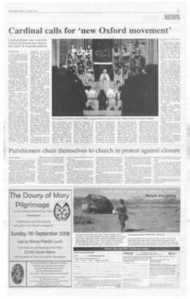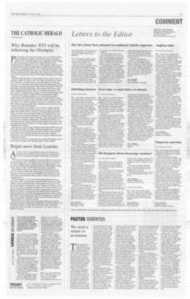Page 13, 8th August 2008
Page 13

Report an error
Noticed an error on this page?If you've noticed an error in this article please click here to report it.
Tags
Share
Related articles
The 'pawns' Move Out Of Check
The Nazi War Effort Was Undone By Incompetence
A Warrior To The Core
Korea Revisited: When The West Fought The East
Unsung Heroes
men with savage hearts
Max Hastings convincingly explains why the Japanese were such dangerous and formidable opponents during the Second World War, says Jack Carrigan
Retribution: The Battle for Japan, 94445 by Max Hastings, Alfred A Knopf £25 This book follows Max Hastings's study of Germany between 1944 and 1945, entitled Armageddon. As Hastings points out, the war in the Far East had second-class status compared to the European one.
In his account he tries to be scrupulously fair; there are disasters and failures on both sides and the price exacted by the Allies against Japan is shown to be a result both of Japan's refusal to accept defeat and the barbarism it had displayed towards those it conquered, civilian and military.
Hastings resists the glamour of war and any sense of military triumphalism. The loss of lives is too great, some through accidents "inseparable from all military operations" but most through campaigns, such as the battle for Iwo Jima, about which he observes, "in every war sacrifices are routinely made out of all proportion to the significance of the objectives."
What concerns him is the portrayal of a "massive and terrible human experience", how and why things were done, and by whom.
He makes critical assessments of all the chief players, such as Churchill, Roosevelt, MacArthur, Chiang Kai-shek and the Emperor Hirohito and asks: "How many people are fitted to grapple with decisions of the magnitude imposed by global war?" For Hastings, the only redemptive feature of war is the brotherhood which it forges: "comradeship... is the only force that makes [unendurable] circumstances durable".
Central to Hastings's argument is the outlook and behaviour of the Japanese. Whereas American and British forces did not regard it as dishonourable to surrender when resistance was no longer sustainable, the Japanese followed the harsh samurai code of bushido, where compassion and surrender was seen as a weakness; not for these men the western ideal of chivalry, in which magnanimity towards a fallen enemy was a sign of strength. Such uncompromising values also affected civilians: thousands of Japanese on Saipan, including women and children, chose to leap to their death from seashore cliffs rather than surrender to the Americans in July 1944.
Nowhere is this "demented" outlook more proven than the short. brutal lives of the kamikaze pilots. When Japan could no longer chal lenge the overwhelming superiority of the Allies in conventional terms it came up with this gruesomely effective means of warfare.
The first suicide mission took place on October 21 1944; between this date and August 1945, 3,913 kamikaze pilots were known to have died. As Hastings points out, there is a huge difference between individual acts of bravery that make death likely and the institutionalisation of a tactic that makes death inevitable.
Few belligerents in war "can boast unblemished records in the treatment of prisoners", yet the Japanese practised "extraordinary refinements of inhumanity".
Only four per cent of British and US POWs died at German hands, whereas 27 per cent of Allied prisoners lost their lives in Japanese captivity. Yet what is less well known is that the Japanese treated the Asian populations they conquered with even greater cruelty than that they meted out to westerners. In Manchuria, they conducted secret vivisection experiments on live prisoners, Hastings estimates that over five million Asians died as a result of Japanese invasion; massacre, destruction, starvation and rape were the inevitable consequences of their presence.
• Hastings's narrative is implicitly dominated by what finally ended the war: the dropping of the atomic bombs on Hiroshima and Nagasaki. He provides a detailed, comprehensive and sober account of this horrifying conclusion, placing it in its wider context and concluding that the use of atomic weaponry "contributed decisively towards preserving the world ever since" precisely because it was so dreadful.
The morality of this decision will always be argued. Hastings reminds us that more people died in the firebombing of Tokyo and Dresden than died at Hiroshima and Nagasaki. The US bomber attack on Tokyo of March 9 1945 killed over 100,000 people. Discussing the personalities of General Curtis LeMay (whose B29s had already firebombed 58 Japanese cities) and Sir Arthur "Bomber" Harris, he drily observes that "few successful warriors are sensitive men or congenial fireside companions".
Yet final responsibility for their actions must lie with their leaders: Churchill, Roosevelt and Truman. They and their fighting men had been desensitised by years of war; a colossal weariness had built up to get it over with by any means, as well as a corresponding impatience with the Japanese determination to fight to the last man. They did not know then of the effects of radiation sickness and saw the bombs simply as "mass multiples" of the destructive capacity of the conventional B-29s. With retrospective knowledge, there is a sickening feeling of inevitability in reading of the events that led finally to Hiroshima and Nagasaki. From June 1945 onwards only Truman's direct veto or unconditional Japanese surrender could have saved the two doomed cities; neither was forthcoming.
Truman, thrust into supreme power late in the day, relied on his experts and the Japanese high command, unbelievably, still held out even after the atomic impact until the Emperor himself finally persuaded the Japanese people to "bear the unbearable" and accept defeat on the Allied terms.
For the author, final blame must lie with the Japanese militarists, who, unlike the Nazi high command, were educated men of high birth, yet whose tragic pride and obstinacy caused their country and millions of other peoples, the extremity of suffering.
As well as quoting official documentation, Hastings's narrative is made more vivid by his skilled use of ordinary people's letters, diaries and memories, such as an eyewitness account of the Japanese soldiers in India against General Slim's 14th Army: "These small men with savage hearts and hands that can paint exquisite watercolours in their diaries, which they leave lying in the red mud." He has mastered an enormous canvas. This is military history at its best.
blog comments powered by Disqus

















